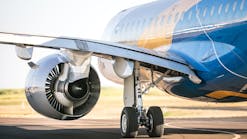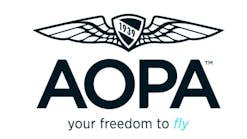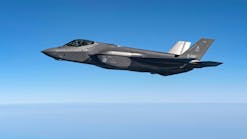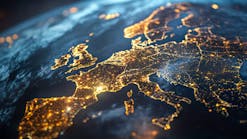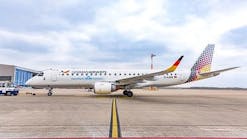Aircraft owners and manufacturers could pay significantly more for transactions involving components from foreign countries due to new tariffs, according to legal experts.
Whether selling or purchasing a new aircraft, organizing a maintenance contract or ordering parts from an OEM, owners may experience higher costs when any part of the aircraft originates from outside the US while the proposed tariffs are active.
This was a key takeaway from the webinar hosted by the National Air Transportation Association (NATA) on April 10, 2025, to discuss the impact of new tariffs on the aerospace industry and business aviation.
Who has to pay?
A central topic of the discussion was who’s responsible for paying the tariff, with a focus on buying and selling aircraft as well as aerospace manufacturing.
David M. Hernandez of Shareholder Vedder Price, P.C. explained, “Importer of record, under the customs regulations, is responsible for paying the tariff…and the CDP person will tell you, ‘You have a 10% tariff on this widget. Please pay it now.’ You have, I think, seven days.”
David T. Norton, partner at Shackleford, Bowen, McKinley & Norton, LLP, responded, “Presumably, the person who's really going to end up paying, either directly or indirectly, is the consumer, right? Because if the producer or the manufacturer has to build in that cost, they're going to have to raise prices to some extent, to absorb [the cost]. They’re not going to make things and sell them at a loss because of the tariff.”
Hernandez supported Norton’s claim, adding, “Some manufacturers say they're going to eat part of it. Others are going to pass part of the money over or pass part of the cost over…A representative said they've talked to hundreds of companies, and all of the companies, virtually all of them, said they're going to have to pass these costs on to consumers, because think about taking a 10% hit on your bottom line.”
Later, Norton brought up another factor in this determination: identifying the importer of record.
Norton stated, “When you're doing an inbound aircraft, part of the question always becomes: who's going to do the import? It kind of depends on where you do the import in the process of the transaction. Traditionally…if I'm representing a US buyer, I try and get the seller to import…Well, if they're importing a Gulfstream, it doesn't matter. But now, if they're importing a Bombardier aircraft that has never been imported to the US yet, even if it’s on that registry, now you’ve got to do the analysis of who's going to become the importer of record and what are the ramifications of that.”
Norton also discussed how existing contracts that didn’t consider tariffs may need to be revisited to designate responsibility for the added costs.
Norton said, “Every contract is going to have some language of the allocation of tax and governmental assessments, but when I did a contract three years ago on a Bombardier product or Dassault product that's getting delivered now, we weren't thinking about tariffs, right?”
How do the tariffs work in the aviation sector?
Jenny Ann Urban, VP regulatory affairs at NATA, gave a disclaimer at the start of the webinar, noting that it had been planned previously to the 90-day pause on tariffs for all countries except China announced on April 9.
Urban said, “This is an always-changing topic at the moment. So, there may be things said on this webinar, and there could be an announcement later this afternoon that could change that.”
Hernandez started with the importance of understanding related legislation.
Hernandez said, “But the big picture is, every manufacturer is now subject to—and hard suppliers and such—to a 10% tariff, except for those covered under the USMCA…And it applies when you import an aircraft or part or engine into the United States.”
He also explained, “The difference now, though, is you need a certificate of origin that says that it is indeed covered under the USMCA, and you get that from the manufacturers…you actually have to have a piece of paper saying that this product, engine, parts, etc. is covered under the USMCA.”
Later, Paul A. Lange, managing member at Law Offices of Paul A. Lange, LLC, gave more insight into certificates of origin.
Lange said, “…that's where the OEMs are now trying to figure out in their supply chains where all the parts come from…there's challenges where parts may originate in the US, then get shipped to another country for assembly, and then come back. And that's creating an awful lot of questions as well that have not typically been addressed in existing maintenance agreements.”
Norton added, “And the key thing that I think a lot of people are missing is the tax is based on where that airplane or that part was manufactured or originated from. It doesn't depend on who the owners are or where you are. For our purposes, the question is, are you importing into the United States something that was manufactured outside of the United States, or improved?”
Norton later also noted, “And so, you can be buying a US-based airplane, but it may have a really significant foreign engine on it. You may be buying foreign aircraft that has lots of US [components]. I mean, that's what triggers it. It doesn't matter what aircraft registry it’s on…What matters is who made it and has it been imported in the US.”
How can a customs broker help?
One resounding solution that all panelists supported was working with a customs broker to organize new deals, especially those that involve aircraft or components from countries outside the US.
Hernandez explained the role of a customs broker, highlighting their value.
Hernandez said, “They are the handholder. They are the person that has read the documents. They're the experts with respect to imports and exports. And they fill out the documents for you.”
“Norton added, “They’re the facilitator, they know all the logistical groups of who to talk to…they're the ones that make sure all the documentation is correct, that the right bonds are in place. Part of it is the analysis of who's the right person to be doing what. They'll help you look at the transaction and say, ‘This is the person that needs to do this.”
Urban asked, “When do y'all recommend hiring a customs broker? And can you explain the importance involving a customs broker, considering many industry members have probably never used or interacted with one before?”
Norton responded, “I would say hire them immediately. If you know there's going to be any question on the requirement to import either the entire aircraft or part of the aircraft, or export… you really want a qualified aviation broker that knows exactly what codes to use and what the current process is.”
Norton advised on how to start preparation with a customs broker, recommending, “You do want to break out exactly: are you buying a part? Are you buying a particular installation services? Are their labor and man hours? You want to parse that all out and then work with the provider and your customs broker to see, as of today, tariff du jour, what applies.”
Lange also noted the critical need for consulting with a customs broker in these times, mentioning that many professionals turn to the Federal Aviation Act, US Code, CFRs and handbooks and orders for guidance.
Lange explained, “…not everything is in handbooks and orders. And then many of us in the industry then have that separate guidance that never made it into the handbooks and orders…There are those kinds of things in the customs world as well, and why it's particularly, not only useful and helpful, but I'd argue, necessary to have the customs broker on board early to help spot those issues and avoid the unintended consequences that others of us might not even think about.”
How to prepare for tariffs that impact aerospace sales, services and manufacturing
The panelists also gave specialized advice for professionals in aerospace about how to prepare generally for the potential impact of tariffs on their transactions.
Early in the webinar, Hernandez mentioned, “These certifications that you may get for an exemption are covered under the 18 U.S.C., or the perjury law. And so, it's very important to make sure that you do your research and, when you certify, that these things are either subject to ‘new NAFTA’ or exempt from tariffs for whatever reason. It has to be accurate, it's important to consult with customs brokers and/or legal counsel.”
He later added, “Every contract, every transaction document going forward, needs to specify who's responsible for the tariffs.”
Lange echoed the importance of being meticulous with documentation.
Lange said, “My suggestion would be to document—keep good records, contemporaneous notes—so that if somehow, something goes wrong, you can at least prove that there was no criminal intent, no intent to defraud, that you don't have an 18 U.S.C. problem, that you fraudulently sign some federal government document that could put you at risk, whether it be jail time, whether it be fines, just an investigation, just all the things that you don't need.”
Additionally, Karen Huggard, VP government affairs at NATA, recommended sharing stories about how tariffs affect manufacturers in the industry in real time.
Huggard stated, “…We as an industry need to be very intentional in the coming months about telling the story about the quality of US manufacturing, the positive trade balance that aerospace and civil aviation enjoys globally, the strong manufacturing sector that we have here in the US and the threats to that sector by the imposition of new tariffs.”


